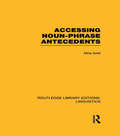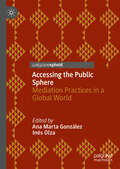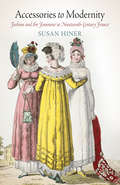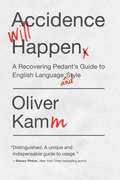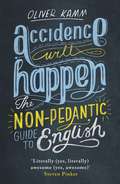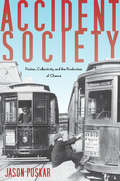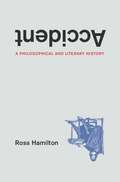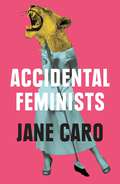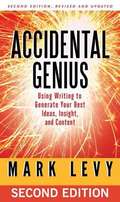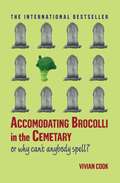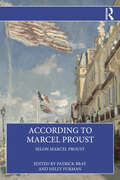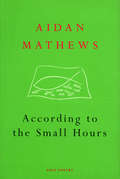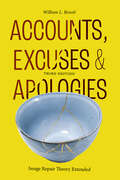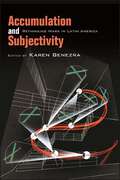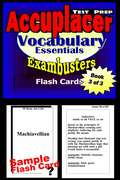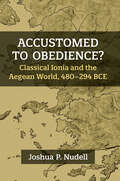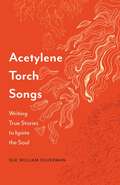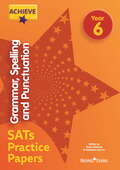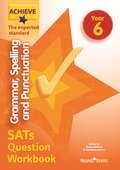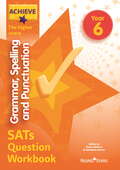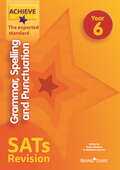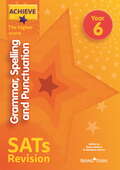- Table View
- List View
Accessing Complex Texts (Student Reader Grade #5)
by Douglas Fisher Nancy Frey"Students closely read and annotate short complex text passages, as well as participate in collaborative conversations, answer text-dependent questions, and write about the text. Each book includes six units of instruction, each featuring three reading passages linked by a common topic."
Accessing Noun-Phrase Antecedents: Linguistics: Accessing Noun-phrase Antecedents (Routledge Library Editions: Linguistics)
by Mira ArielAccessing Noun-Phrase Antecedents offers a radical shift in the analysis of discourse anaphora, from a purely pragmatic account to a cognitive account, in terms of processing procedures. Mira Ariel defines referring expressions as markers signalling the degree of Accessibility in memory of the antecedent. The notion of Accessibility is explicitly defined, the crucial factors being the Salience of the antecedent, and the Unity between the antecedent and the anaphor. This analysis yields an astonishing array of new results. The precise distribution of referring expressions in actual discourse is directly predicted. Several universals of anaphoric relations are stated. Thus, although not all languages necessarily have the same markers, and nor do they assign them precisely the same function, Ariel shows that they all obey the same Accessibility marking hierarchy. This book will be compulsory reading for anyone with an interest in the semantics and pragmatics of referring expressions, in the interaction of semantics and pragmatics, and more generally in the interaction between peripheral and central cognitive systems.
Accessing the Public Sphere: Mediation Practices in a Global World
by Ana Marta González Inés OlzaThis edited volume focuses on the (un)equal access to the public space granted to the various groups that make up hybrid and multicultural societies: i.e. majority vs minority groups, immigrants vs non-immigrants, and so forth. With ‘access to public space’ the authors refer not only to participation through discursive practices in the public arena (e.g. political, social and institutional debates) but also to a full operationalization of the knowledge, habits and opportunities attached to true citizenship. Furthermore, in contexts of inequality and sociocultural conflict, the role of mediators has always been underscored as third-party figures (in)formally acknowledged and authorized–by participants in the interaction and/or external bodies–to set the ground for mutual understanding and foster balanced communication. Such mediation can range from interpreting in legal and medical encounters to dispute-resolution practices in situations of sociocultural clash among groups or individuals. Therefore, as is shown by the contributions in this volume, (intercultural) mediators are key agents in facilitating integration and providing disadvantaged groups with effective tools to gain access to the public sphere.
Accessories to Modernity: Fashion and the Feminine in Nineteenth-Century France
by Susan HinerAccessories to Modernity explores the ways in which feminine fashion accessories, such as cashmere shawls, parasols, fans, and handbags, became essential instruments in the bourgeois idealization of womanhood in nineteenth-century France. Considering how these fashionable objects were portrayed in fashion journals and illustrations, as well as fiction, the book explores the histories and cultural weight of the objects themselves and offers fresh readings of works by Balzac, Flaubert, and Zola, some of the most widely read novels of the period.As social boundaries were becoming more and more fluid in the nineteenth century, one effort to impose order over the looming confusion came, in the case of women, through fashion, and the fashion accessory thus became an ever more crucial tool through which social distinction could be created, projected, and maintained. Looking through the lens of fashion, Susan Hiner explores the interplay of imperialist expansion and domestic rituals, the assertion of privilege in the face of increasing social mobility, gendering practices and their relation to social hierarchies, and the rise of commodity culture and woman's paradoxical status as both consumer and object within it.Through her close focus on these luxury objects, Hiner reframes the feminine fashion accessory as a key symbol of modernity that bridges the erotic and proper, the domestic and exotic, and mass production and the work of art while making a larger claim about the "accessory" status—in terms of both complicity and subordination—of bourgeois women in nineteenth-century France. Women were not simply passive bystanders but rather were themselves accessories to the work of modernity from which they were ostensibly excluded.
Accidence Will Happen: A Recovering Pedant's Guide to English Language and Style
by Oliver KammA witty, authoritative, and often provocative guide to the use and abuse of the English language, by the London Times's lead grammar columnist. Are standards of English alright—or should that be all right? To knowingly split an infinitive or not to? And what about ending a sentence with preposition, or for that matter beginning one with "and"? We learn language by instinct, but good English, the pedants tell us, requires rules. Yet, as Oliver Kamm cleverly demonstrates in this new book, many of the purists' prohibitions are bogus and can be cheerfully disregarded. Accidence Will Happen is an authoritative and deeply reassuring guide to grammar, style, and the linguistic conundrums we all face.
Accidence Will Happen: The Non-Pedantic Guide to English Usage
by Oliver KammAre standards of English alright - or should that be all right?To knowingly split an infinitive or not to?And what about ending a sentence with preposition, or for that matter beginning one with 'and'?We learn language by instinct, but good English, the pedants tell us, requires rules. Yet, as Oliver Kamm demonstrates, many of the purists' prohibitions are bogus and can be cheerfully disregarded. ACCIDENCE WILL HAPPEN is an authoritative and deeply reassuring guide to grammar, style and the linguistic conundrums we all face.'A unique and indispensable guide to usage' STEVEN PINKER'An immensely intelligent and playful polemic, cheeky and erudite by turns...certainly gets the blood pumping, so do read it' THE TIMES'A superb book' INDEPENDENT
Accident Society: Fiction, Collectivity, and the Production of Chance
by Jason PuskarThis book argues that language and literature actively produced chance in the late nineteenth and early twentieth centuries by categorizing injuries and losses as innocent of design. Automobile collisions and occupational injuries became "car accidents" and "industrial accidents." During the post-Civil War period of racial, ethnic, and class-based hostility, chance was an abstract enemy against which society might unite. By producing chance, novels by William Dean Howells, Stephen Crane, Anna Katharine Green, Edith Wharton, Theodore Dreiser, and James Cain documented and helped establish new modes of collective interdependence. Chance here is connected not with the competitive individualism of the Gilded Age, but with important progressive and social democratic reforms, including developments in insurance, which had long employed accident narratives to shape its own "mutual society." Accident Society reveals the extent to which American collectivity has depended--and continues to depend--on the literary production of chance.
Accident: A Philosophical and Literary History
by Ross HamiltonFrom ancient philosophy to Tristram Shandy and Buster Keaton movies, this book tells the engaging history of accident as an idea. An accidental glance at a newspaper notice causes Rousseau to collapse under the force of a vision. A car accidentally hits Giacometti, and he experiences an epiphany. Darwin introduces accident to the basic process of life, and Freud looks to accident as the expression of unconscious desire. Accident, Ross Hamilton claims, is the force that makes us modern. Tracing the story of accident from Aristotle to Buster Keaton and beyond, Hamilton’s daring book revives the tradition of the grand history of ideas. Accident tells an original history of Western thought from the perspective of Aristotle’s remarkably durable categories of accident and substance. Throughout antiquity and the Middle Ages, Aristotle’s distinction underwrote an insistence on order and subordination of the inessential. In a groundbreaking innovation, Hamilton argues that after the Reformation, the concept of accident began to change places with that of substance: accident became a life-transforming event and effectively a person’s essence. For moderns, it is the accidental, seemingly trivial moments of consciousness that, like Wordsworth’s “spots of time,” create constellations of meaning in our lives. Touching on a broad array of images and texts—Augustine, Dante, the frescoes of Raphael, Descartes, Jane Austen, the work of the surrealists, and twentieth-century cinema—Hamilton provides a new way to map the mutations of personal identity and subjectivity.
Accident: A Philosophical and Literary History
by Ross HamiltonFrom ancient philosophy to Tristram Shandy and Buster Keaton movies, this book tells the engaging history of accident as an idea. An accidental glance at a newspaper notice causes Rousseau to collapse under the force of a vision. A car accidentally hits Giacometti, and he experiences an epiphany. Darwin introduces accident to the basic process of life, and Freud looks to accident as the expression of unconscious desire. Accident, Ross Hamilton claims, is the force that makes us modern. Tracing the story of accident from Aristotle to Buster Keaton and beyond, Hamilton’s daring book revives the tradition of the grand history of ideas. Accident tells an original history of Western thought from the perspective of Aristotle’s remarkably durable categories of accident and substance. Throughout antiquity and the Middle Ages, Aristotle’s distinction underwrote an insistence on order and subordination of the inessential. In a groundbreaking innovation, Hamilton argues that after the Reformation, the concept of accident began to change places with that of substance: accident became a life-transforming event and effectively a person’s essence. For moderns, it is the accidental, seemingly trivial moments of consciousness that, like Wordsworth’s “spots of time,” create constellations of meaning in our lives. Touching on a broad array of images and texts—Augustine, Dante, the frescoes of Raphael, Descartes, Jane Austen, the work of the surrealists, and twentieth-century cinema—Hamilton provides a new way to map the mutations of personal identity and subjectivity.
Accident: A Philosophical and Literary History
by Ross HamiltonFrom ancient philosophy to Tristram Shandy and Buster Keaton movies, this book tells the engaging history of accident as an idea. An accidental glance at a newspaper notice causes Rousseau to collapse under the force of a vision. A car accidentally hits Giacometti, and he experiences an epiphany. Darwin introduces accident to the basic process of life, and Freud looks to accident as the expression of unconscious desire. Accident, Ross Hamilton claims, is the force that makes us modern. Tracing the story of accident from Aristotle to Buster Keaton and beyond, Hamilton’s daring book revives the tradition of the grand history of ideas. Accident tells an original history of Western thought from the perspective of Aristotle’s remarkably durable categories of accident and substance. Throughout antiquity and the Middle Ages, Aristotle’s distinction underwrote an insistence on order and subordination of the inessential. In a groundbreaking innovation, Hamilton argues that after the Reformation, the concept of accident began to change places with that of substance: accident became a life-transforming event and effectively a person’s essence. For moderns, it is the accidental, seemingly trivial moments of consciousness that, like Wordsworth’s “spots of time,” create constellations of meaning in our lives. Touching on a broad array of images and texts—Augustine, Dante, the frescoes of Raphael, Descartes, Jane Austen, the work of the surrealists, and twentieth-century cinema—Hamilton provides a new way to map the mutations of personal identity and subjectivity.
Accidental Feminists
by Jane CaroWomen over fifty-five are of the generation that changed everything. We didn't expect to. Or intend to. We weren't brought up much differently from the women who came before us, and we rarely identified as feminists, although almost all of us do now. Accidental Feminists is our story. It explores how the world we lived in—with the pill and a regular pay cheque—transformed us and how, almost in spite of ourselves, we revolutionised the world. It is a celebration of grit, adaptability, energy and persistence. It is also a plea for future generations to keep agitating for a better, fairer world.
Accidental Genius: Using Writing to Generate Your Best Ideas, Insights, and Content
by Mark LevyLevy shows readers how to tap into their most powerful creative thinking by using a variety of writing exercises. This second edition includes updates on how to use these exercises to generate raw material for books, articles, presentations, blog posts, and tweets.
Accomodating Brocolli in the Cemetary: Or Why Can't Anybody Spell?
by Vivian Cook"It is a damn poor mind that can think of only one way to spell a word." -- Andrew Jackson Weird or wierd? Necessary or neccessary? Recomend or recommend? English spelling is fiendish, but that doesn't mean you can't have fun with it. Accomodating Brocolli in the Cemetary is at once a celebration of spelling and a solace to anyone who has ever struggled with the arcane rules of the English language. As amusing as he is informative, Vivian Cook thrills the reader with more than a hundred entries -- from photographs of hilariously misspelled signs to quizzes best taken in private to schadenfreude-rich examples of spelling errors of literary greats -- that will tickle the inner spelling geek in every reader. It all adds up to a gem of a book that takes a wry look at the hodgepodge evolution of spelling and the eccentric way it actually works. Difficult Words Spelling Test Circle whichever one is right. 1. dessicate desiccate desicate 2. ecstasy exstacy ecstacy 3. adress adres address 4. dumbel dumbbell dumbell 5. accomodate accommodate acommodate 6. necesary neccesary necessary 7. liaison liaision liason 8. pronounciation pronounceation pronunciation 9. ocurence occurrence occurence 10. embarass embaras embarrass 11. brocolli broccolli broccoli 12. refering referring refferring 13. cemetery semetary cemetary
According to Marcel Proust: Selon Marcel Proust
by Patrick Bray and Nelly FurmanFrench novelist, literary critic, and essayist Marcel Proust (1871–1922) was one of the most prominent authors of the twentieth century. This innovative edition features excerpts from In Search of Lost Time in their original French with the English translation en face.Whereas many introductory guides to Proust’s novel attempt to follow the development of the narrative, this guide focuses on Proust’s approach to writing as an art, one that can represent the changes brought by personal experiences as well as new inventions and historical events. Daunting in volume, in its range of topics, in its many characters, In Search of Lost Time requires steadfast attention and a discerning understanding not only of time, people, and place, but also of the expressivity of literary language. This guidebook entices readers to either start or renew their interest in Proust by presenting short citations from À la recherche du temps perdu (1913–1927) gathered around ten topics: Proust’s Project; Literature and Writing; Memory and Time; Art; Love and Jealousy; Sodom and Gomorrah; High Society; Objects; The Dreyfus Affair; and World War I. By including short extracts, this edition allows readers time to focus attention on specific issues dealing with Proust’s project, allowing readers to rediscover Proust or discover Proust for the first time. These accessible bilingual citations from À la recherche du temps perdu make an invaluable text for students of French or comparative literature, as well as translation, literature, and culture.
According to the Small Hours
by Aidan MathewsIn this, his first collection of poems in fifteen years, Aidan Mathews brings together the sacred and the profane, playful and profound, the iconic and the everyday - illuminating the variousness and commonality of human experience. These poems wear their erudition lightly: dazzling us with their fresh observations, the strangely intimate details ('mice among the breadcrumbs of the Last Supper') and a fluid, metaphysical wit that can link a saint's matyrdom to a Sunday roast. Mercurial, passionate and always surprising, According to the Small Hours is a triumphant return to the form.
Accounts, Excuses, and Apologies, Third Edition: Image Repair Theory Extended
by William L. BenoitIn our constantly plugged-in and connected world, image is everything. People, groups, organizations, and countries frequently come under suspicion of wrongdoing and sometimes require defense. Accounts, Excuses, and Apologies describes the image-repair strategies that may be used to help defuse these threats.The Third Edition of this classic book builds on theories for rehabilitating a damaged reputation by adding two new forms of denial: straw denial (appearing to deny an accusation by sidestepping it) and deflecting attention (trying to get the audience to focus on something other than the accusations against you). Five contexts for image repair are examined: corporate, political, sports/entertainment, international, and third party (when one person or organization tries to repair the image of another). The book’s case studies include current instances of reputation repair, including Vladimir Putin on Ukraine and President Joe Biden on Afghanistan; Southwest Airlines on flight cancellations; Kobe Bryant on accusations of rape; and Donald Trump on the January 6 hearings.
Accumulation and Subjectivity: Rethinking Marx in Latin America
by Karen BenezraSince the 1970s, sociocultural analysis in Latin American studies has been marked by a turn away from problems of political economy. Accumulation and Subjectivity challenges this turn while reconceptualizing the relationship between political economy and the life of the subject. The fourteen essays in this volume show that, in order to understand the dynamics governing the extraction of wealth under contemporary capitalism, we also need to consider the collective subjects implied in this operation at an institutional, juridical, moral, and psychic level. More than merely setting the scene for social and political struggle, Accumulation and Subjectivity reveals Latin America to be a cauldron for thought for a critique of political economy and radical political change beyond its borders. Combining reflections on political philosophy, intellectual history, narrative, law, and film from the colonial period to the present, it provides a new conceptual vocabulary rooted in the material specificity of the region and, for this very reason, potentially translatable to other historical contexts. This collection will be of interest to scholars of Marxism, Latin American literary and cultural studies, and the intellectual history of the left.
Accuplacer Test Prep Flash Cards: Vocabulary Review (Exambusters Accuplacer Workbook #3 of 3)
by Ace Inc.<P><P><i>Advisory: Bookshare has learned that this book offers only partial accessibility. We have kept it in the collection because it is useful for some of our members. Benetech is actively working on projects to improve accessibility issues such as these.</i><P><P> 500 essential words every student should know. Includes sample sentence, part of speech, pronunciation, succinct, easy-to-remember definition, and common synonyms and antonyms. <P> Exambusters Accuplacer Prep Workbooks provide comprehensive, fundamental Accuplacer review--one fact at a time--to prepare students to take practice Accuplacer tests. Each Accuplacer study guide focuses on one specific subject area covered on the Accuplacer exams. From 300 to 600 questions and answers, each volume in the Accuplacer series is a quick and easy, focused read. Reviewing Accuplacer flash cards is the first step toward more confident Accuplacer preparation and ultimately, higher Accuplacer exam scores!
Accustomed to Obedience?: Classical Ionia and the Aegean World, 480–294 BCE
by Joshua P. NudellMany histories of Ancient Greece center their stories on Athens, but what would that history look like if they didn’t? There is another way to tell this story, one that situates Greek history in terms of the relationships between smaller Greek cities and in contact with the wider Mediterranean. In this book, author Joshua P. Nudell offers a new history of the period from the Persian wars to wars that followed the death of Alexander the Great, from the perspective of Ionia. While recent scholarship has increasingly treated Greece through the lenses of regional, polis, and local interaction, there has not yet been a dedicated study of Classical Ionia. This book fills this clear gap in the literature while offering Ionia as a prism through which to better understand Classical Greece. This book offers a clear and accessible narrative of the period between the Persian Wars and the wars of the early Hellenistic period, two nominal liberations of the region. The volume complements existing histories of Classical Greece. Close inspection reveals that the Ionians were active partners in the imperial endeavor, even as imperial competition constrained local decision-making and exacerbated local and regional tensions. At the same time, the book offers interventions on critical issues related to Ionia such as the Athenian conquest of Samos, rhetoric about the freedom of the Greeks, the relationship between Ionian temple construction and economic activity, the status of the Panionion, Ionian poleis and their relationship with local communities beyond the circle of the dodecapolis, and the importance of historical memory to our understanding of ancient Greece. The result is a picture of an Aegean world that is more complex and less beholden narratives that give primacy to the imperial actors at the expense of local developments.
Acetylene Torch Songs: Writing True Stories to Ignite the Soul
by Sue William SilvermanAt times writers—from the unpublished to jaded lifers—need a fire lit under them to pursue the complex work of self-exploration. Acetylene Torch Songs provides that spark for memoirists and essayists seeking mentor-based instruction and inspiration. Drawing on twenty-five years of teaching and mentoring writers, Sue William Silverman stresses practice over theory. She encourages craftiness as well as craft and urges writers to embark on emotional quests in pursuit of their art. Acetylene Torch Songs uniquely illustrates how the writer&’s imaginative spirit comes alive on the page through metaphor, literary masks, sensory memories, voice, obsessions, and more. This holistic approach to writing emphasizes how the creative process brings together the heart, mind, and senses to illuminate the human condition through language. Featuring a personal essay in each chapter, Silverman uses her own work to model a specific concept or approach, demonstrating how obsessions, secrets, and memories can burn on the page. Through guided prompts, worksheets, checklists, publishing advice, personal essays, and strategies, Silverman encourages writers to find the confidence and courage to write stories that reach beyond the page through their intimacy, social engagement, and honesty.
Achieve Grammar, Spelling and Punctuation SATs Practice Papers Year 6 (Achieve Key Stage 2 SATs Revision)
by Marie Lallaway Madeleine BarnesAchieve. Fun and focused SATs revision.Achieve the Expected Standard in Grammar, Punctuation and Spelling, with the only fully updated revision series. Written in the style of the most recent Year 6 National Tests, this essential book is packed with full length tests papers, providing realistic practice to develop and perfect exam technique for the 2019 SATs and covers everything that could be tested while ensuring children have some fun while they learn.Our unique approach has been helping children and schools perform above national average for over 15 years. This full colour write-in book:- Builds children's ability to concentrate in a test situation - Familiarises children with the style and format of the SATs with exposure to all the question types that could be set- Identifies strengths and weaknesses to help guide revision and improve results- Saves teacher and parent preparation time with ready-made practice papers- Draws on expert analysis to ensure our content is just right For best results use alongside Achieve Grammar, Spelling and Punctuation SATs Revision The Expected Standard Year 6 and Achieve Grammar, Spelling and Punctuation SATs Question WorkbookThe Expected Standard Year 6
Achieve Grammar, Spelling and Punctuation SATs Question Workbook The Expected Standard Year 6 (Achieve Key Stage 2 SATs Revision)
by Marie Lallaway Madeleine BarnesAchieve. Fun and focused SATs revision.Achieve the Expected Standard in Grammar, Punctuation and Spelling, with the only fully updated revision series. Written in the style of the most recent Year 6 National Tests, this indispensable workbook will help children gain familiarity with the style of questions which will appear in the 2019 tests and covers everything that could be tested while ensuring children have some fun while they learn.Our unique approach has been helping children and schools perform above national average for over 15 years. This full colour write-in workbook:- Focuses practice on the areas of the curriculum needed to reach the expected standard- Builds exam confidence with questions and terminology that mirror the SATs- Provides clear explanations, top tips and digestible content - making it perfect for use in school or at home- Draws on expert analysis to ensure our content is just right Perfect for use alongside Achieve Grammar, Spelling and Punctuation SATs Revision The Expected Standard Year 6 and Achieve Grammar, Spelling and Punctuation SATs Practice Papers Year 6
Achieve Grammar, Spelling and Punctuation SATs Question Workbook The Higher Score Year 6 (Achieve Key Stage 2 SATs Revision)
by Marie Lallaway Madeleine BarnesAchieve. Fun and focused SATs revision.Achieve the Higher Score in Grammar, Spelling and Punctuation, with the only fully updated revision series.Written in the style of the most recent Year 6 National Tests, this indispensable workbook will help more able children gain familiarity with the style of the more demanding areas of the 2019 national tests and covers everything that could be tested while ensuring children have some fun while they learn.Our unique approach has been helping children and schools perform above national average for over 15 years. This full colour write-in workbook:- Focuses practice on the areas of the curriculum needed to reach the higher score- Increases exam confidence with questions and terminology that mirror the SATs- Clearly shows children what examiners are looking for when marking extended questions- Draws on expert analysis to ensure our content is just right Perfect for use alongside Achieve Grammar, Spelling and Punctuation SATs Revision The Higher Score Year 6 and Achieve Grammar, Spelling and Punctuation SATs Practice Papers Year 6
Achieve Grammar, Spelling and Punctuation SATs Revision The Expected Standard Year 6 (Achieve Key Stage 2 SATs Revision)
by Marie Lallaway Madeleine BarnesAchieve. Fun and focused SATs revision.Achieve the Expected Standard in Grammar, Punctuation and Spelling, with the only fully updated revision series. This book teaches children exactly how to tackle SATs questions (even the tricky ones) with confidence to get their best result. This book covers everything that could be tested while ensuring children have some fun while they learn.Our unique approach has been helping children and schools perform above national average for over 15 years. Children are guided step-by-step through all question types and easy-to-digest content is presented in a simple to follow format. Clear explanations and lots of practice make it the perfect revision range for use in school and at home. This revision book:- Teaches children how to tackle SATs questions ...and get them right!- Focuses revision for the greatest impact on final marks- Draws on expert analysis to ensure our content is just right - Provides full guidance by topic, and includes important facts, keywords, SATs terminology, tips and example practice questions - Offers digestible content and lots of opportunities to practise,making it perfect for use in school or at homeFor best results use alongside Achieve Grammar, Spelling and Punctuation SATs Question WorkbookThe Expected Standard Year 6 and Achieve Grammar, Spelling and Punctuation Practice Papers
Achieve Grammar, Spelling and Punctuation SATs Revision The Higher Score Year 6 (Achieve Key Stage 2 SATs Revision)
by Marie Lallaway Madeleine BarnesAchieve. Fun and focused SATs revision.Achieve the Higher Score in Grammar, Punctuation and Spelling, with the only fully updated revision series. This book teaches children exactly how to tackle the more demanding SATs questions with confidence to get their best result. For use with more able children, this book covers everything that could be tested and provides additional challenge while ensuring children have some fun while they learn.Our unique approach has been helping children and schools perform above national average for over 15 years. Children are guided step-by-step through all question types and easy-to-digest content is presented in a simple to follow format. Clear explanations and lots of practice make it the perfect revision range for use in school and at home. This revision book:- Focuses revision on the key information children need to reach the higher score- Shows children how to get full marks on extended questions- Teaches children how to answer test questions thoughtfully and appropriately- Offers digestible content and lots of opportunities to practise,making it perfect for use in school or at homeFor best results use alongside Achieve Grammar, Spelling and Punctuation SATs Question WorkbookThe Higher Score and Achieve Grammar, Spelling and Punctuation SATs Practice Papers

